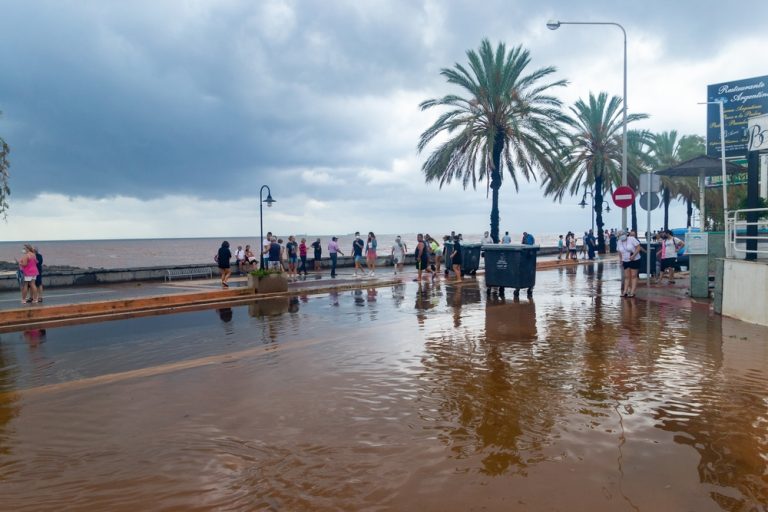As Hurricane Milton barrels toward Florida’s Gulf Coast, analysts warn the global insurance industry could face losses up to $100 billion. The Category 5 storm, one of the most powerful to approach the region in recent history, is expected to make landfall between late Wednesday and early Thursday. If the storm’s path takes it directly through densely populated areas like Tampa, the financial impact could rival that of Hurricane Katrina in 2005, which remains the costliest U.S. natural disaster to date.
Hurricane Milton: A Potentially Historic Event
Milton’s projected insured losses range between $60 billion and $100 billion, according to analysts at Morningstar DBRS. Should the storm strike Tampa directly, it could become one of the most destructive hurricanes on record. The area has barely begun recovering from the devastation caused by Hurricane Helene just two weeks ago, compounding concerns about the region’s readiness to weather yet another catastrophic event.
While $100 billion in losses would place Milton on par with Hurricane Katrina, which also devastated the Gulf Coast nearly two decades ago, a lower estimate of $60 billion would align Milton’s impact more closely with Hurricane Ian in 2022. Ian caused significant damage when it struck Florida, resulting in about $60 billion in insured losses.
Reinsurance Rates Set to Surge
In anticipation of these losses, experts predict a sharp increase in reinsurance prices as insurers adjust to the heightened risk environment. RBC analysts note that while Milton’s potential impact on the industry is “very manageable,” it will likely lead to higher premiums and tougher contract terms during the 2025 policy renewals.
“Better reinsurance contract terms, broader earnings diversification, and bigger reserve buffers should put the sector in better stead than before,” RBC analysts stated, suggesting that insurers have taken measures to cushion the financial blow of natural disasters in recent years. The changes could be a boon for companies like Swiss Re, Munich Re, and Lloyd’s of London insurers, who are poised to benefit from a surge in reinsurance pricing.
The Insurance Sector Braces for Impact
The arrival of Hurricane Milton has already caused stock prices for major reinsurers to dip. Shares in companies such as Swiss Re, Munich Re, and Lloyd’s of London firms Beazley, Hiscox, and Lancashire have fallen this week, despite recent highs following a series of strong earnings reports. Analysts remain optimistic, however, that these stocks will rebound as the market anticipates harder pricing for reinsurance renewals in the coming months.
Analysts at Peel Hunt have noted that Milton’s potential landfall scenario bears a striking resemblance to a $134 billion loss projection made by Lloyd’s of London earlier this year in one of its Realistic Disaster Scenarios. These scenarios are designed to stress test the market against large-scale catastrophic risks, and Milton’s potential trajectory across the Florida Peninsula is seen as a near-realization of such a scenario.
How Climate Change Is Exacerbating Risks
The increased frequency and intensity of natural disasters, like Hurricane Milton, are often linked to the effects of climate change. As global temperatures rise, storms have become more severe and unpredictable, leading insurers to adapt by raising rates and excluding high-risk policies. The trend is driving a shift in how the industry manages catastrophe risk, with reinsurers and insurers alike seeking more favorable terms to protect against escalating losses.
While scientists caution that no single weather event can be definitively attributed to climate change, the broader pattern suggests a future where extreme weather events become more common, thus challenging insurers to develop strategies to manage increasingly complex risk portfolios.
The Long-Term Outlook for Reinsurers
Despite the immediate market reaction, analysts foresee a recovery in the shares of global reinsurers as they position themselves to capitalize on rising premiums. With reinsurance rates for many insurance contracts being set on January 1, the aftermath of Milton could bring a wave of “harder pricing,” which would improve profitability across the sector.
RBC analysts noted, “It’s only a matter of time before shares regain lost ground as prospects of harder pricing at the subsequent policy renewals set in.” The coming years could offer significant growth potential for insurers with broader earnings diversification and stronger reserve buffers despite the near-term financial strain caused by large-scale disasters like Hurricane Milton.
As Hurricane Milton bears down on Florida, the potential for record-breaking losses underscores the growing challenges facing the insurance industry amid an era of more frequent and severe natural disasters. While the financial impact could approach $100 billion, rivaling the devastation wrought by Hurricane Katrina, the industry’s adaptation to evolving risks offers some reassurance. As reinsurance rates surge and contract terms tighten, insurers may find opportunities for growth in the midst of adversity.


